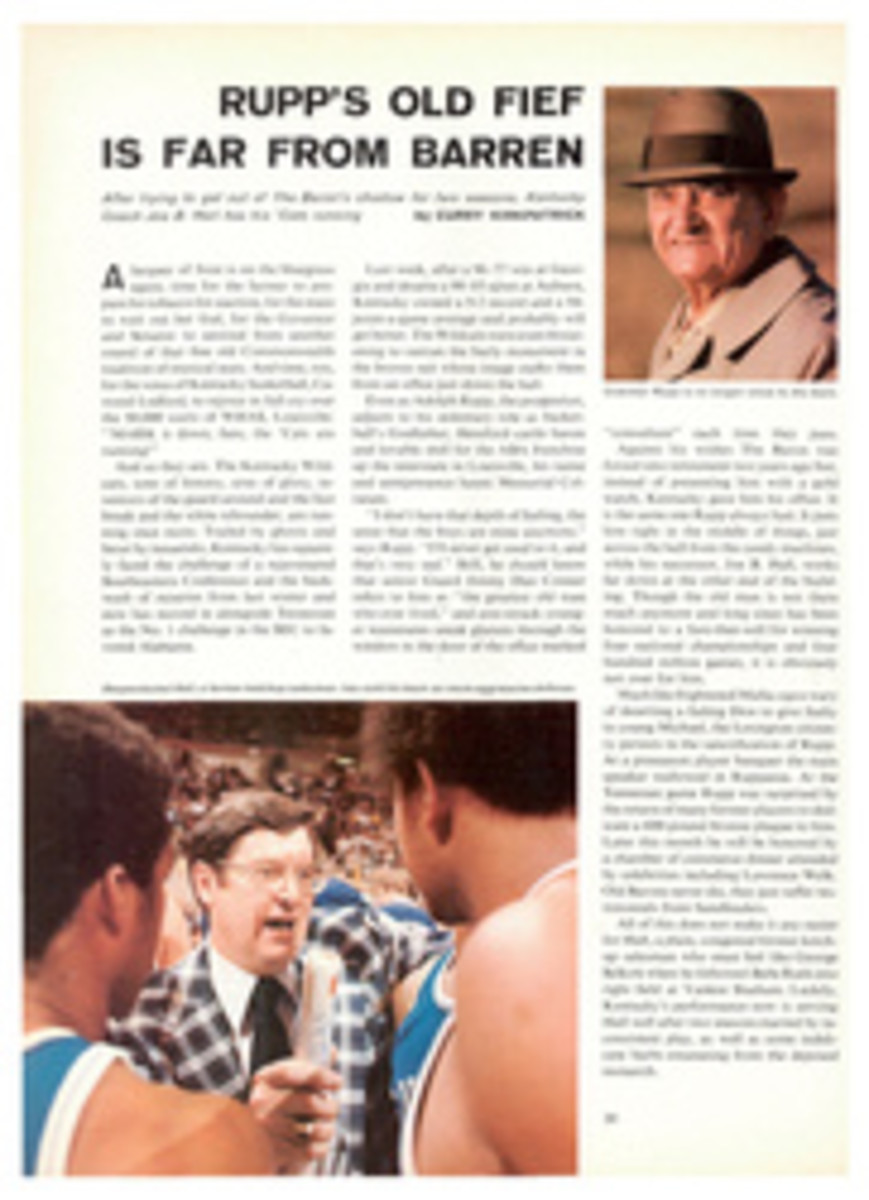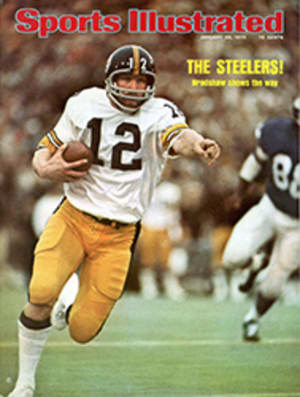
SCORECARD
SCORE ONE FOR THEWOMEN
There is only oneway to view the events that took place in Washington last week when a recordnumber of delegates (954, including 44 college presidents, also a record)gathered for the 69th annual National Collegiate Athletic Associationconvention. The NCAA's directors had their heads handed to them by theAssociation for Intercollegiate Athletics for Women, which was convened 1,410miles away in Houston. The NCAA deserved at least as much.
The debacle hadits beginnings last year when representatives of the two organizations met todiscuss affiliation. But soon after, the NCAA Council went on its own tack andsecretly drew up plans for a women's program to be administered by the men.Suspicions were aroused that all was not right in a pre-convention interviewgranted by the NCAA executive director of many years, Walter Byers. He favoredstarting women's athletics at the club level, ignoring the fact that the womenwere already well launched. Thereafter, women "should beaccorded...financing to the level of their interest." He did not considerthe women's 2% share of all funds spent on athletics inadequate.
Word next leakedfrom Washington that the NCAA would announce a pilot program offering nationalchampionship competition for women. Dr. Norman Miller, a UCLA vice-chancellor,said in Houston, "It is the biggest betrayal of my life." ChancellorHerbert Schooling of the University of Missouri assured the AIAW of hisbacking, and President Robert MacVicar of Oregon State said he favored tablingthe NCAA proposal pending discussion with the women.
It was a steelyaudience that faced a Byers assistant, Tom Jernstedt, whose appearance beforethe AIAW had been promised by the NCAA. The slipshod nature of the NCAA'splanning was soon evident in his evasive answers to a steady drumming ofquestions. Why the necessity of championships when the AIAW already was staging11 title events? No answer. Why were women not to run the program or even be inon the planning of it? No idea. Jernstedt did not know, either, how the pilotprogram could be financed or what the NCAA would do about such non-membercolleges as Wellesley, Smith and Immaculata, the three-time AIAW basketballchampion.
Under strongpressure from Houston and cries of "piracy," the NCAA delegates passeda resolution calling for a joint committee to study women's athletics andreport back in 1976.
This was to havebeen a historic NCAA convention. Other areas of major consideration were costcutting and rules infractions and enforcement. Considerable headway was made inthe latter category, but absolutely nothing was accomplished as far ascurtailing operating costs was concerned, a plan to return to one-platoonfootball (see below) not even reaching a vote. One suspects that if importantsavings were to be made, they would be in the women's program, but the womenwere having none of it. That was historic.
TWO FOR ONE
Whether to returnto one-platoon football or not is a problem with surprising twists. While itwas assumed at the NCAA convention that only the financially pressed smallerschools favored limiting substitution, it was the University of Oregon thatattempted to raise the issue and Penn State's Joe Paterno who earlier hadpresented the strongest arguments for a cutback. On the other hand, Coach BillRamseyer of little (660 students) Wilmington College in Ohio thinks that areturn to one platoon would be the very thing to force the small schoolsunder.
Ramseyer reasonsthis way: football at Wilmington attracts about 50 freshman candidates a year.Since there are no athletic scholarships, the players pay the same tuition andfees as other students. They enroll at Wilmington because they know they willhave a chance to play. Take that away and they will have less reason to go toWilmington and, says Ramseyer, "very few small colleges can stand to losestudents now."
As ludicrous asit seems, if Ramseyer is right—and costs for the huge squads and bloatedcoaching staffs at the big schools keep increasing—the solution may be formajor schools to readopt one-platoon football while smaller institutions standpat.
IT FEELS SOGOOD
It took a bit of undoing, but Willard Norris finally has got off for a shortholiday. In a two-week span, the National Hockey League linesman 1) broke hisnose, 2) suffered a 16-stitch cut in his right hand and 3) broke a bone in hisright leg. He was given 10 days of unbroken time to recuperate.
QUID PRO QUO
Joey Rosenzweigis eight and an autograph nut. One night a few weeks ago his father took him tothe Nassau Coliseum for his first professional basketball game. He had his bookfirmly in hand and his priorities under stern control. He was after bigmen.
"Who'sthat?" he asked as a particularly tall Net strode by.
"BillyPaultz," his father said.
"He lookslike a good one," Joey exulted and darted on court during the pre-gamewarmup to nail the 6'11" center. Suddenly, as he looked up from his own4'11" height, Joey's nerve left him. He stood speechless, but after amoment he brightened.
"If you'llsign my autograph book," he told Paultz, "I'll protect you againstmidgets."
When Paultz couldstop laughing, he signed.
THE PRICE OFPROGRESS
There issomething wonderfully old fashioned in college soccer's All-America selections.It is as though the '20s were back and stout men from Washington &Jefferson and Lafayette and Centre were taking their places on Walter Camp'sfootball All-America alongside the Harvards and Yales and Princetons and,occasionally, a lone Ohio Stater.
The mostacclaimed player of the year, Farrukh Quraishi, played his midfield for OneontaState in New York. Michael Ian Bain and Bruce Hudson, close behind, were fromHoward and St. Louis. The team included stars from Wooster of Ohio, Loyola ofBaltimore, the University of Missouri at St. Louis, Southern IllinoisEdwardsville and Keene (N.H.) State. Not that better-known schools were leftout. There were two selections from the University of Connecticut, an Air Forcemidfielder, even a goalie from Cornell and a striker from UCLA.
Those who playthe game in this country hope passionately for the day when their All-Americawill rank in importance with the many manufactured for college football. Butshould such popularity come, there is no doubt which schools would dominate theselections. The Bridgeports, Hartwicks and Cortland States would live only asfond memories.
HIGH OLD CAMP
Walter Camp didmore than review the football season and choose All-America teams. He was aphysical education buff who swore by exercise. His Daily Dozen, a phrase thatlives on in the American idiom, had a profound effect on a generation broughtup in the ample shadows of trenchermen like President William Howard Taft andDiamond Jim Brady. In fact, just this New Year's one of Camp's disciples wasnamed a knight on Queen Elizabeth's list of honors. He is P. G. Wodehouse, theBritish-born humorist who gave the world that proper butler Jeeves and thatproper ass Gussie Fink-Nottle and who, at 93, is still turning out at least anovel a year. As he has done every morning since 1919 when they first appearedin American magazine, Wodehouse began the day of the announcement with all 12Camp exercises.
There is nothingin Camp's background to suggest a strong orientation to the East, but hisroutine is remarkably similar to the tai-chi phase of wu shu, the Chinesediscipline that emphasizes deep breathing and slow, undemanding repetitionrather than the vigorous leaping about seen often today. In Camp's firstexercise, for example, one merely stands erect, hands at side and feet at a60-degree angle. By the second exercise he has advanced to placing his hands onhis hips. The most strenuous is No. 9, the crouch, done slowly five times.
Wodehouse admitsto weakness in his legs and relies on a cane when he walks. He had a bad fallsome time ago and broke a table but reported proudly that he did not seem tohave done much harm to himself. As Fink-Nottle would say, "Whatho!"
BREAKTHROUGH?
During lastspring's protracted negotiations that brought the National and Americanbasketball associations close to merger, the ABA proposed a solution to thatbugbear of all professional sports, the reserve clause, that merits moreserious study than it received at the time. It may well turn out to be theprototype for future player-management agreements.
The reserveclause binds a player to one team until he is traded or sold, when he is boundby contract again. In its place the ABA suggested what it called the "firstright of refusal." The provision would allow any team to negotiate with aplayer from another team, but the club that owned the services of theplayer—through draft or otherwise—would have the right to make a counter offer.According to Mike Storen, ABA commissioner at the time of the merger talks, theidea was to retain a measure of control over the movement of players whilegiving them bargaining power to improve their position. "Under thesystem," he says, "players would reach their true value instead of thevalue they negotiated when they came out of college. The better players whodeserve more would get more, and the journeymen who weren't worth as muchprobably would earn less."
Storen believesthat the federal court ruling on Joe Kapp (Scorecard, Jan. 6) "makes ourproposal...look like we were five years ahead of our time." He could bewrong there. First right of refusal has the ring of a sterling idea that won'twait that long.
THOSE ARE THEBREAKS
Hurst, Texas, a Dallas suburb, went three straight years without a pedestriandeath, and there was Mayor Bob Hampton receiving a safety award from theAmerican Automobile Association—in his hospital bed. The mayor was recoveringfrom a concussion, a couple of broken bones in his shoulder and assorted cutsand bruises. Fell off his bike.
THEIR TOWN
If you have notbeen particularly aware of the fact, the people of East Chicago, Ind. have.Three basketball players who graduated from Washington High in 1971, PeteTrgovich, Junior Bridgeman and Tim Stoddard, start for UCLA, Louisville andNorth Carolina State, which were ranked second, third and fourth nationallylast week. A fourth player, Darnell Adell, transferred from Murray State and isbeing redshirted at North Carolina State, where he may start at guard nextseason.
East Chicago wasriding a hot streak. The state champ in 1970 was Roosevelt down the street fromWashington. That team was led by Jim Bradley. He will be recalled as thepleasant giant who took Northern Illinois University to national ranking beforequitting last year to join the ABA's Kentucky Colonels.
THEY SAID IT
•Mark Shannon, Springfield College basketball star,asked what he would do if he were a coach: "I'd be demanding, stern, happy,concerned, encouraging, respectful, gracious and aggressive. I'd be a hell of acoach."
•David Owen, Toronto Zoo executive, explaining thezoo's intention to get more animals: "We are acutely conscious of the highprofile of the low animal count."
•Eddie Sutton, Arkansas basketball coach, commentingon the decision of the Southwest Conference to use lie-detector tests duringinvestigations of recruiting violations: "If you strapped a couple ofcoaches I know into a polygraph chair, they'd be electrocuted."
ILLUSTRATION

